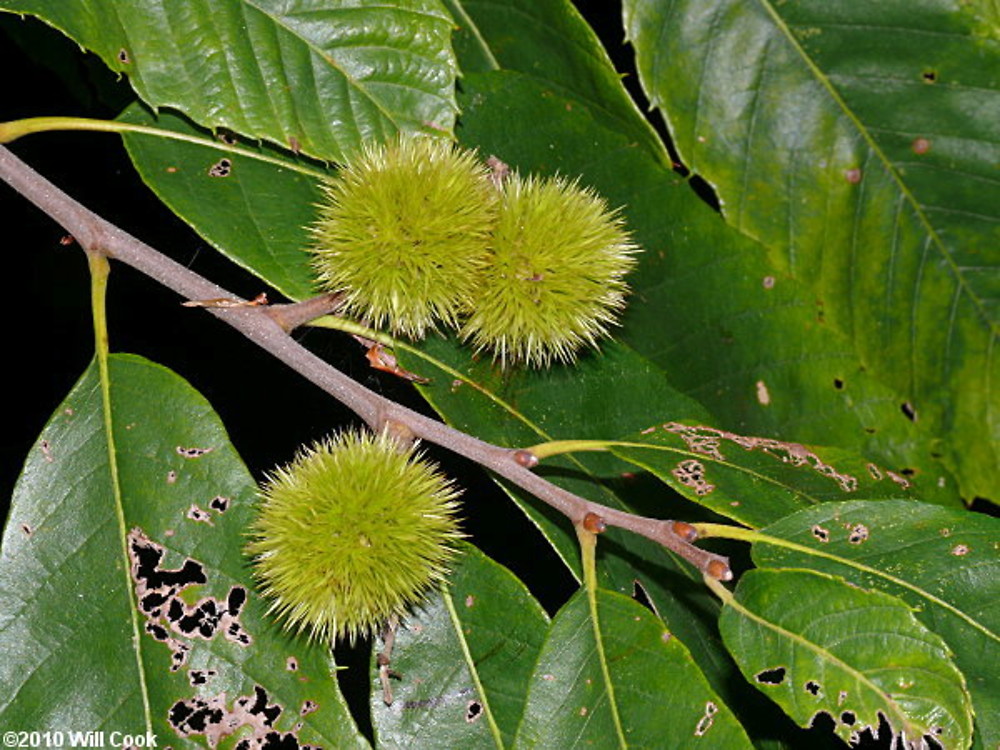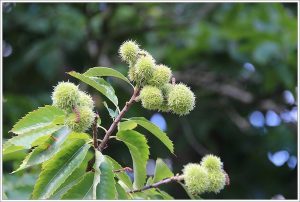
The little chestnut that survived. Photo by Will Cook, North Carolina Plant Photos.
One way to think of Chinquapins is they are small Chestnuts that survived. In the same genus as their bigger relative — Castenea — when the blight wipeout the Chestnuts Chinquepins suffered but some managed to survive. One can see the Allegany Chinquepin (C. pumila) while hiking the Appalachian Trail. Their nut is about half of the size of their deceased relative but still worth collecting. We also know some of the nutrition of another edible Chinquepin, the Ozark Chinkapin (C. ozarkensis.)

Chinquapins pack a lot of nutrition.
Per 100 grams it has 443 calories, 18 grams of fat, 57 grams of carbohydrates, 13 grams of protein and 6 grams of fiber. The fat is 10 grams monounsaturated, 4 grams polyunsaturated and 4 grams saturated. Potassium is 77 mg, no sodium reported. A second report says they are 5% fat, 55 protein, 40% starch and 50% water with 4736 calories per kilo. European chestnuts, not affected by blight, are the only cultivated and consumed nut that has vitamin C, about 40 mg per 3.5 ounce serving.
In the Beech family the Chinkapin has been called them most ignored and undervalued native North American nut tree. It has a sweet and edible nut and has been used for fuel, charcoal, fence posts, railroad ties and a coffee and chocolate substitute (as are the seeds of the Blue Beech, aka the American Hornbean, Carpinus caroliniana.)
Just how many “Castanea” species there are is anyone’s guess. For example the USDA uses the name Castanea pumila for the Allegany Chinkepin. They say it is also called American chinquapin, C. alnifolia, C. ashei, C. floridana, C. margaretta, C. nana, C. paucispina, chinquapin, dwarf chestnut, Fagus pumila, and Golden Chinquapin. We are fairly sure C. ozarkensis is a separate species. C. davidii, C. seguinii, C. mollissima and C. henryi are from Asia, C. creanata, Japan. To my knowledge all of them have edible nuts. Chinkapin’s native range is New Jersey and West Virginia, west to Missouri and Oklahoma, and south to Texas and Florida. It’s been planted in Wisconsin and Michigan.
Green Deane Itemized Plant Profile
IDENTIFICATION: Chinkapin is a small tree or large shrub that grows six to 15 feet tall. Twigs are densely hairy when young becoming shiny brown with reddish-hairy buds. The leaves alternate, are simple, short-stemmed, prominently veined, oblong with fine pointed teeth or bristles, and hairy on the lower surface. The fruit is a spiny bur with a single nut. Bur opens like a clam shell.
TIME OF YEAR: Early September with some leeway for location.
ENVIRONMENT: It does not like limestone or sand dunes. Prefers mixed hardwood forests with pines and oaks on ridges and slopes, under 4450 feet. Heat tolerant but intolerant of salt spay or shade.
METHOD OF PREPARATION: Shelled nuts eaten raw or roasted.

